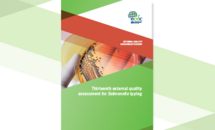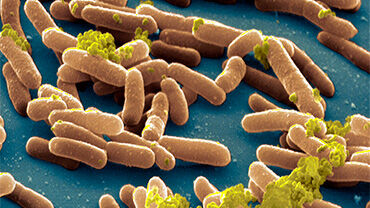Thirteenth external quality assessment for Salmonella typing
Infection with Salmonella spp. is the second most reported zoonotic disease in humans, with 65 208 reported cases in the European Union (EU) in 2022. Salmonella is also the bacteria associated with most foodborne outbreaks. The overall EU trend in salmonellosis incidence for the years 2017 to 2021 has not changed significantly. To prevent foodborne diseases such as salmonellosis from further spread, it is essential to employ human surveillance systems at different levels to monitor the disease and ensure early detection and response to outbreaks.
Executive Summary
ECDC has set surveillance objectives to monitor trends and carry out multinational outbreak detection of salmonellosis and other pathogens. In addition, objectives will contribute to the evaluation and monitoring of prevention and control programmes; identify population groups at risk and in need of targeted prevention; contribute to the assessment of burden of disease; generate hypotheses on sources and transmission modes, and identify needs for research projects.
The fulfilment of these surveillance objectives relies heavily on the data provided by the National Public Health Reference Laboratories (NPHRL) of the EU and European Economic Area (EEA) countries. To monitor the typing methods used, data quality and comparability, and the capability of the laboratories performing these methods, ECDC commissions an annual External Quality Assessment (EQA) scheme for the serotyping and molecular-based cluster analysis of Salmonella.
This thirteenth external quality assessment scheme for Salmonella typing (EQA-13) was sub-contracted to the National Institute for Public Health and the Environment (RIVM) and consisted of a serotyping part and a molecular typing-based cluster analysis part. Participants were expected to use routinely applied methods for both parts of the EQA and were assessed on their performance. Serotyping consisted of 12 isolates with different, carefully selected serovars. For cluster analysis, two different sets of 10 Salmonella isolates were selected (for whole genome sequencing [WGS]/Pulsed-field gel electrophoresis [PFGE] and Multiple locus variable-number tandem repeat analysis [MLVA]), containing cluster and non-cluster isolates. These isolates mimicked a real outbreak situation, originating from a dinner on a cruise ship. In addition, raw reads of five isolates were made available to the participants that used WGS for cluster analysis. These isolates acted as food isolates and participants were asked which food product was most likely to have caused the outbreak.
For serotyping, 28 laboratories participated and 54% (15/28) used phenotypical serotyping, based on agglutination with antisera only, while 11% (3/28) used a combination of agglutination with antisera and molecular methods other than WGS. In all, 14% (4/28) of the laboratories used a combination of agglutination with antisera and prediction of serotype with WGS, and 21% (6/28) used prediction of serotype with WGS only. Performance was high for most laboratories, with 16 laboratories achieving performance scores of 100% and six of 92%. The six laboratories that had the lowest performance values (<92%) used phenotypic methods. Overall performance in serotyping was better if the serotype was predicted using WGS than if it was assessed using phenotypic methods alone (p=0.0090, ꭕ2).
Twenty-four laboratories took part in the molecular typing-based cluster analysis, which was an increase compared to the previous two EQAs. In both, EQA-12 (2022) and EQA-11 (2021), 20 laboratories participated in the molecular typing-based cluster analysis. In EQA-13, the proportion of participants that used WGS for their cluster analysis increased from 85% to 96% compared to EQA-12, while the number of participants that applied multiple locus variable-number tandem repeat analysis (MLVA)-based cluster analysis decreased from 15% to 13%. The number of participants using pulsed-field gel electrophoresis (PFGE)-based cluster analysis also decreased from 10% (two participants) to 4% (one participant). All participants that used MLVA also used WGS for cluster analysis.
In the WGS-based cluster analysis, most participants 91% (21/23) applied a gene-by-gene approach, while the other 9% (2/23) applied SNP-typing. In total, 22 different combinations of platforms, approaches, kits, cluster analysis tools, typing schemes and cluster cut-offs were used. However, the methods used did not affect the high performance, with an overall performance score of 96% correct cluster assignment for the isolates and sequences provided. Nineteen laboratories had 100% performance in assigning the provided isolates to clusters and three additional laboratories incorrectly assigned only one of the isolates provided.
Three laboratories applied MLVA-based typing and produced identical MLVA profiles, except for allele SENTR4 in strain EQA2329, indicating a high technical performance of 98% (49/50 alleles). However, overall performance for cluster assignment of provided isolates was lower (82%) than with WGS-based cluster analysis (96%, p=0.0022), as two isolates were included in the outbreak cluster based on MLVA profiles by two laboratories, and one isolate was excluded based on MLVA profiles by one laboratory. Therefore, participating laboratories had good capability in applying MLVA, but the resolution of the technique itself was too low to correctly assign isolates to clusters.
Since only one laboratory applied PFGE-based cluster analysis, this laboratory’s performance could not be compared with the others. The participant correctly identified all isolates belonging to the cluster but could only exclude two isolates. The use of PFGE-based cluster analysis is not recommended because of the inferior resolution, the poor portability and the limited usage which hampers its use in (inter)national outbreak assessments involving multiple institutes and therefore restricts the fulfilment of ECDC’s surveillance objectives.
Laboratories are recommended to use WGS-based cluster analysis, as a minimum in outbreak situations. Member States are asked to submit Salmonella WGS data in real-time to TESSy to be used for EU-wide WGS-enhanced salmonellosis surveillance. WGS data should be submitted whenever new data are available in laboratories or in relation to on-going multi-country outbreak investigations. Sharing of WGS data allows ECDC to perform regular multi-country cluster detections for Salmonella while supporting and improving the timeliness of multi-country outbreak investigations.
The EQA-13 assessed the typing methods used, their quality and comparability, and the capability of the performing laboratories. Results from a feedback survey showed that multiple laboratories took corrective action based on the results of EQA-13, proving the added value of this EQA for the typing capability of the NPHRLs in EU/EEA countries. Ensuring that the NPHRLs operate at maximum capability and capacity contributes to high standards of surveillance and outbreak detection at both regional and national level, and fulfils the international surveillance objectives of ECDC and the European Food- and Waterborne Diseases and Zoonosis Network (FWD-Net).
Download







